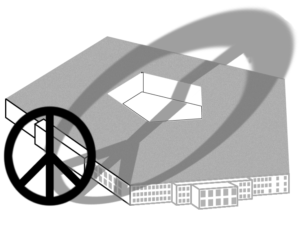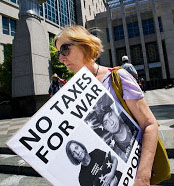I find myself torn once again between getting myself out the door to be at a demonstration versus doing all the personal and behind-the-scenes political projects that are piled up around me.
This weekend is the Women’s March on the Pentagon, a protest initiated by Cindy Sheehan and inspired by the 51st anniversary of the 1967 march on the Pentagon — a spirited event with a turnout of 50,000 on October 21, 1967. Such a turnout is exceedingly unlikely this weekend, despite the couple hundred individual and group endorsers listed on the website, including our own National War Tax Resistance Coordinating Committee.
Within our war tax resistance network, initial interest in having a group presence there has dwindled to whether I’m going to get myself out the door and to DC with some lit and my “divest from war” sign for the Saturday workshops and Sunday march and rally. (There is still time to let me know if you will be there!) The travel to DC — whether by car, bus, or train — is one of my least favorite. But being in a crowd of whatever size with like-minded folks keeping the antiwar movement present will probably still entice me. It has also prompted me to reflect on the great Women’s Pentagon Actions of November 1980 and 1981 and WRL’s Day Without the Pentagon Action in October 1998 (you can listen to some of the speeches in the Democracy Now archive, including war tax resister Clare Hanrahan!).
The war tax resistance movement, such as it is, has always had a tension between taking the action for personal reasons and being part of a more public group of resisters. I have generally seen that people come to war tax resistance because they have been active on antiwar/ justice issues for some time, and the growing conflict between working for change and paying for the status quo (or worse) has led them to tax resistance. That often means they are already active with another group that is usually their primary activist outlet.

WRL’s Day Without the Pentagon logo, Nov. 1998.
I expect there will be many WTRs at the Women’s March on the Pentagon, and there will be signs demanding “no taxes for war.” I will have some people ask for literature or how to resist. And at the next NWTRCC gathering there will be a discussion about outreach and effective strategies. Being at demonstrations will probably be low on the list, though it still makes sense to me that people who show up at demonstrations are more likely to be ready resist than those “liking” WTR posts on social media. It is hard to quantify though, so we try to do some of everything.
There are other gatherings this fall that will include discussions about personal WTR and WTR outreach and organizing, including the annual New England Gathering of War Tax Resisters and Supporters and Maine War Tax Resistance Gathering. You can find info about both of those events on NWTRCC’s Programs and Gatherings page — and you can ask that your local or regional events get posted there too.
Meanwhile, I’ll continue the fight with myself about getting to DC. If you see my photos on Facebook next week, you’ll know if I got there or not!
— Post by Ruth Benn
P.S. All credit to The Clash for the title of this blog!






Thanks, Ruth, for writing about your struggle to decide priorities. I’ve gone through the same thoughts about going to Cleveland in November. Will miss the gathering a lot, but maybe next time I can go. Greetings to my wtr friends who read my comment.
Since it was completed in 1943, the Pentagon has proven to be a most appropriate location for demonstrations opposing U.S. wars and militarism. Filling out Ruth’s key citations, here are a few more (though likely not exhaustive):
July 1946 – First demonstration (of which I’m aware) was a protest of the Bikini nuclear testing in the Pacific, the first nuclear tests since the bombings of Hiroshima and Nagasaki the year before
November 1960 – 1,000 Quakers surround the Pentagon in a silent vigil to commemorate the 300th anniversary of the Friends Peace Testimony
June 1962 – First civil disobedience at the Pentagon as 16 are arrested attempting to enter the “War Room” to protest nuclear weapons during the Committee for Nonviolent Action (CNVA) Walk for Peace
June 1965 – CNVA organized “speak-out” with 250 demonstrators protest the Vietnam War vigil and hand out leaflets at all entrances and even inside the Pentagon
November 1965 – Quaker Norman Morrison immolates himself outside Sec. of Defense Robert McNamara’s office in a protest of the Vietnam War
May 1967 – Boston to Pentagon Walk for Peace, organized by CNVA to protest the Vietnam War, included a vigil, a camp-in with tent (blocking the Joint Chiefs of Staff offices), being evicted and reentering over a 4-day period until 20 were eventually arrested
October 1967 – The most famous demonstration at the Pentagon was the Confront the War Makers action that included 50,000 people and resulted in 700 being arrested, which produced many iconic images and was the subject of Norman Mailer’s “Armies of the Night”
1969-1970 – Episcopal Peace Fellowship organized a series of masses as witness against the Vietnam War, including one on Nov. 13, 1969, which resulted in 186 being arrested
July 1970 – CNVA organizes the first blood pouring, which was at the Mall entrance
May 1971 – During the May Day actions hundreds of demonstrators marched from Washington, DC, to the Pentagon but were stopped and arrested by the police before getting there
October 1976 – During the final day of the Continental Walk for Disarmament and Social Justice, 700 people walked from the Lincoln Memorial to the Pentagon, where 53 were arrested including former Pentagon employee Dan Ellsberg
1976 to present – Jonah House and Catholic Worker periodically (at times daily) conduct actions to protest nuclear war and militarism by throwing blood and ashes, digging graves, etc.
April 1980 – As part of the Coalition for a Non-Nuclear World actions, 1,500 marched from the DoE to the Pentagon and 600 were arrested
November 1980 – Women’s Pentagon Action included 2,000 marchers who wove yarn across the entrances, and over 140 were arrested blocking three of the entrances
November 1981 – The second Women’s Pentagon Action included 3,500 women, 65 of whom were arrested
August 1985 – Thousands of people, as part of The Ribbon Project, encircled the Pentagon with 25,000 panels of cloth quilted by peace activists warning of the danger of nuclear war
October 1988 – CISPES organized more than 1,000 people in a demonstration to protest the U.S.-funded death squads in El Salvador
April 1997 – Dozens of people marched to the Pentagon to protest funding the School of Americas, resulting in the arrest of 15 people as they dug graves symbolizing the deaths of innocent civilians
October 1998 – WRL organizes A Day without the Pentagon that included a rally and blockade of Pentagon entrances; hundreds participated and 36 were arrested
September 2005 – Protesting the Iraq and Afghanistan Wars, demonstrators blockade Pentagon entrances at which about 40 are arrested